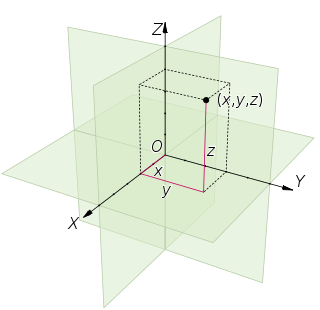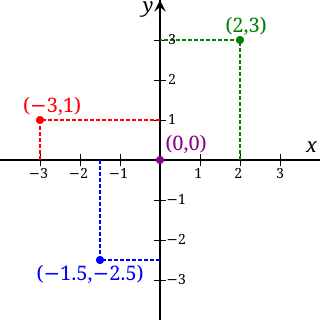Subspace may refer to:
Subspace may refer to:

Euclidean space is the fundamental space of geometry, intended to represent physical space. Originally, in Euclid's Elements, it was the three-dimensional space of Euclidean geometry, but in modern mathematics there are Euclidean spaces of any positive integer dimension n, which are called Euclidean n-spaces when one wants to specify their dimension. For n equal to one or two, they are commonly called respectively Euclidean lines and Euclidean planes. The qualifier "Euclidean" is used to distinguish Euclidean spaces from other spaces that were later considered in physics and modern mathematics.

Linear algebra is the branch of mathematics concerning linear equations such as:

In mathematics and physics, a vector space is a set whose elements, often called vectors, can be added together and multiplied ("scaled") by numbers called scalars. The operations of vector addition and scalar multiplication must satisfy certain requirements, called vector axioms. Real vector spaces and complex vector spaces are kinds of vector spaces based on different kinds of scalars: real numbers and complex numbers. Scalars can also be, more generally, elements of any field.

In Euclidean geometry, an affine transformation or affinity is a geometric transformation that preserves lines and parallelism, but not necessarily Euclidean distances and angles.
In mathematics, a linear combination or superposition is an expression constructed from a set of terms by multiplying each term by a constant and adding the results. The concept of linear combinations is central to linear algebra and related fields of mathematics. Most of this article deals with linear combinations in the context of a vector space over a field, with some generalizations given at the end of the article.

In mathematics, the linear span (also called the linear hull or just span) of a set S of vectors (from a vector space), denoted span(S), is defined as the set of all linear combinations of the vectors in S. For example, two linearly independent vectors span a plane. The linear span can be characterized either as the intersection of all linear subspaces that contain S, or as the smallest subspace containing S. The linear span of a set of vectors is therefore a vector space itself. Spans can be generalized to matroids and modules.

In mathematics, and more specifically in linear algebra, a linear subspace or vector subspace is a vector space that is a subset of some larger vector space. A linear subspace is usually simply called a subspace when the context serves to distinguish it from other types of subspaces.
In mathematics, an algebra over a field is a vector space equipped with a bilinear product. Thus, an algebra is an algebraic structure consisting of a set together with operations of multiplication and addition and scalar multiplication by elements of a field and satisfying the axioms implied by "vector space" and "bilinear".

In mathematics, the concept of a projective space originated from the visual effect of perspective, where parallel lines seem to meet at infinity. A projective space may thus be viewed as the extension of a Euclidean space, or, more generally, an affine space with points at infinity, in such a way that there is one point at infinity of each direction of parallel lines.
In mathematics, a building is a combinatorial and geometric structure which simultaneously generalizes certain aspects of flag manifolds, finite projective planes, and Riemannian symmetric spaces. Buildings were initially introduced by Jacques Tits as a means to understand the structure of isotropic reductive linear algebraic groups over arbitrary fields. The more specialized theory of Bruhat–Tits buildings plays a role in the study of p-adic Lie groups analogous to that of the theory of symmetric spaces in the theory of Lie groups.

In mathematics, an affine space is a geometric structure that generalizes some of the properties of Euclidean spaces in such a way that these are independent of the concepts of distance and measure of angles, keeping only the properties related to parallelism and ratio of lengths for parallel line segments. Affine space is the setting for affine geometry.
This is an outline of topics related to linear algebra, the branch of mathematics concerning linear equations and linear maps and their representations in vector spaces and through matrices.

In mathematics, a group scheme is a type of object from algebraic geometry equipped with a composition law. Group schemes arise naturally as symmetries of schemes, and they generalize algebraic groups, in the sense that all algebraic groups have group scheme structure, but group schemes are not necessarily connected, smooth, or defined over a field. This extra generality allows one to study richer infinitesimal structures, and this can help one to understand and answer questions of arithmetic significance. The category of group schemes is somewhat better behaved than that of group varieties, since all homomorphisms have kernels, and there is a well-behaved deformation theory. Group schemes that are not algebraic groups play a significant role in arithmetic geometry and algebraic topology, since they come up in contexts of Galois representations and moduli problems. The initial development of the theory of group schemes was due to Alexander Grothendieck, Michel Raynaud and Michel Demazure in the early 1960s.
This page lists some examples of vector spaces. See vector space for the definitions of terms used on this page. See also: dimension, basis.

In mathematics, the real coordinate space or real coordinate n-space, of dimension n, denoted Rn or , is the set of all ordered n-tuples of real numbers, that is the set of all sequences of n real numbers, also known as coordinate vectors. Special cases are called the real lineR1, the real coordinate planeR2, and the real coordinate three-dimensional spaceR3. With component-wise addition and scalar multiplication, it is a real vector space.

In linear algebra, a cone—sometimes called a linear cone for distinguishing it from other sorts of cones—is a subset of a vector space that is closed under positive scalar multiplication; that is, C is a cone if implies for every positive scalar s. A cone need not be convex, or even look like a cone in Euclidean space.

In mathematics, a space is a set endowed with a structure defining the relationships among the elements of the set. A subspace is a subset of the parent space which retains the same structure. While modern mathematics uses many types of spaces, such as Euclidean spaces, linear spaces, topological spaces, Hilbert spaces, or probability spaces, it does not define the notion of "space" itself.
In mathematics, projectivization is a procedure which associates with a non-zero vector space V a projective space P(V), whose elements are one-dimensional subspaces of V. More generally, any subset S of V closed under scalar multiplication defines a subset of P(V) formed by the lines contained in S and is called the projectivization of S.
In mathematics and physics, vector is a term that refers to quantities that cannot be expressed by a single number, or to elements of some vector spaces. They have to be expressed by both magnitude and direction.
This glossary of linear algebra is a list of definitions and terms relevant to the field of linear algebra, the branch of mathematics concerned with linear equations and their representations as vector spaces.